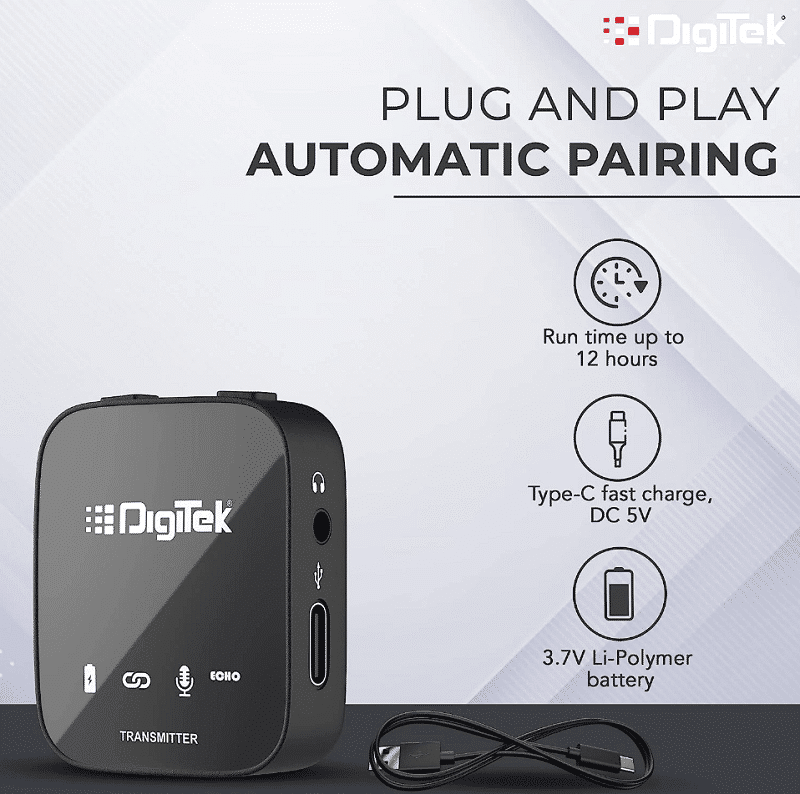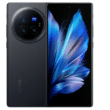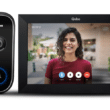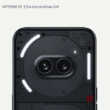Wireless microphone systems capture high-quality audio without the use of cords. They are often utilised in audio and video production scenarios such as interviewing, vlogging, documentaries, and more. These systems, which usually consist of a transmitter and a receiver, work by wirelessly sending audio signals from the microphone to the recording equipment.
Characteristics to check when buying?
Consider the following features when shopping for a wireless microphone system for DSLRs, camcorders, cell phones, and tablets:
- Compatibility: Make sure the microphone system is compatible with the recording device you’re using, whether it’s a DSLR camera, camcorder, smartphone, or tablet. The one that provides many connectivity possibilities should have an advantage.
- Range: Consider the system’s wireless range. When collecting audio in various shooting conditions, a larger range might provide more options.
- Microphone Type: Different systems may use a variety of microphones, including lapel (lavalier) microphones, portable microphones, and shotgun microphones. Choose the one that best meets your recording requirements.
- Battery Life: Check the battery life of both the transmitter and receiver. Longer battery life is required for longer recording sessions.
- Audio Quality: Look for systems with clear, high-quality audio. To increase audio quality, some may have features such as adjustable gain and noise reduction.
- Build Quality: Ensure that the system’s components are long-lasting and well-built to sustain repeated use.
- Ease of Use: A quick setup and user-friendly interface will save you time and stress throughout your recording sessions.
- Price: Take into account your budget and hunt for a system that provides the functionality you require without breaking the bank.
Key factor that you can’t miss……
Interference is a critical consideration when using wireless microphones. Interference can cause audio dropouts, noise, or poor sound quality by disrupting the wireless connection. Consider the following crucial points:
- Frequency Interference: Because wireless microphones use certain radio frequencies, interference can occur if other devices, such as Wi-Fi routers, cell phones, or other wireless microphones, use the same frequency range. This interference can cause audio issues.
- Sources of RF Interference: Identify and avoid potential sources of radio frequency (RF) interference in your environment. Wireless routers, cordless phones, and other electrical equipment that emit RF waves are examples.
- Frequency Coordination: Frequency coordination is critical in professional audio systems. To minimise interference, choose the best available frequencies for your wireless microphones. Scanning and frequency coordination functions in modern wireless systems can aid with this.
- Frequency Bands: Be aware of the frequency bands accessible in your area for wireless microphones. The accessible frequency bands are regulated differently in each nation, and you must follow local legislation to avoid interference and legal complications.
- Signal Strength and Range: It is important to remember that wireless microphone devices have a restricted range. The signal may weaken if the transmitter and receiver are too far away, resulting in dropouts and poor audio quality. Keep to the recommended operating range.
- Battery Life: Always verify and double-check that the transmitter and receiver have enough battery life for the intended use. Running out of battery power during a crucial recording or performance might be disastrous.
- Backup Options: Consider having backup microphones or a backup plan for key applications in case of interference or technical issues with your wireless system.
- Test and Rehearse: Thoroughly test your wireless microphone equipment in the actual surroundings before every key event or recording session to discover and address any potential interference concerns. You can anticipate and mitigate difficulties by practising with the equipment.
- Maintain Firmware upgrades: If your wireless microphone system has firmware upgrades available, keep them up to current. Updates may be released by manufacturers to improve the functionality and security of their products.
You can guarantee that your wireless microphone system works dependably and delivers high-quality audio in a variety of contexts by being aware of potential interference and taking actions to reduce it.
Types of Microphones
To excel in different areas, various microphones are designed for varied applications. Here are some common microphone categories with their high usage arenas.
- Dynamic Microphones:
- Best For: Live sound reinforcement, close-miking instruments, on-stage vocals, recording loud sound sources (e.g., guitar amplifiers, drums).
- Advantages: Durability, high sound pressure level (SPL) handling, minimal sensitivity to background noise.
- Condenser Microphones:
- Best For: Studio recording, capturing vocals and acoustic instruments, podcasting, streaming, and voiceovers.
- Advantages: High sensitivity, wide frequency response, excellent transient response, ideal for capturing subtle details and nuances.
- Lavalier (Lapel) Microphones:
- Best For: Hands-free use in presentations, interviews, public speaking, and theater productions.
- Advantages: Discreet, easily clipped to clothing, minimizes handling noise, ideal for capturing spoken word.
- Shotgun Microphones:
- Best For: Film and video production, location sound recording, capturing directional audio.
- Advantages: Highly directional, reduces ambient noise, ideal for isolating sound sources.
- Ribbon Microphones:
- Best For: Studio recording (especially for vintage or warm tonal characteristics), miking instruments (e.g., guitar cabinets, brass instruments).
- Advantages: Smooth and warm sound, suitable for capturing the character of acoustic instruments.
- USB Microphones:
- Best For: Podcasting, voiceovers, home recording, video conferencing, streaming, and content creation.
- Advantages: Plug-and-play convenience, no need for additional audio interfaces, suitable for beginners.
- Instrument-Specific Microphones:
- Best For: Recording specific musical instruments (e.g., drum microphones, guitar microphones, piano microphones).
- Advantages: Tailored frequency response and design optimized for specific instruments.
- Wireless Microphones:
- Best For: Applications where mobility and freedom of movement are essential (e.g., stage performances, live events, interviews).
- Advantages: Eliminates the need for cables, allows performers and presenters to move freely.
Based on the detailed research and analysis, we found that the below mentioned were listed amongst the best microphones by the users.
1. Digitek wireless microphone and receiver
User friendly,Built-in-50mAh Li-poly battery for up to 4 Hours of operation. Charging via USB(AC adapter or Power Bank-not included).

2. Digitek wireless microphone system for dslr
3. Enhanced headphone monitoring function, allowing you to monitor in real-time while shooting. with 3.5mm interface. with two 3.mm cables, can be used with laptop/PC/DSLR Camera / amplifier/ DV / Camcorder/ smartphone / mixer, etc.
4. 360 degrees Ultra-Clear pickup/receiver equal amount of sound from all directions
5. Crystal-clear audio for any type of content creation.
6. Plug and play-automatic pairing. the signal transmission with low latency & without interruption. suitable for video shooting.
7. High performance wireless transmission-effective up to 30 meters. Ultra stable signal; audio & video synchronization.

8. Digitek wireless microphonedwm 102
9. Carries crystal clear audio for any type of content creation
10. Built in 3.7V / 1800mA Li-Poly Battery on Power Charging Compartment & Built in 3.7V / 300mA Li-Poly Battery on Host works for 12 hrs

FAQ’s
Q. How to use digitek wireless microphone?
Ans: It is user friendly, comes with a manual and hassle free usage.
Q. How to use wireless microphone?
Ans: Generally ‘c’ port is used.
Q. What three things can go wrong when using a wireless microphone?
- Interference:
- Radio Frequency Interference (RFI): Wireless microphones use certain radio frequencies, and if other electrical equipment or neighbouring wireless systems use the same frequencies, interference can occur. Interference in your audio signal might cause static, dropouts, or unwanted noise.
- Physical Obstructions: Physical obstructions such as walls, metal objects, or other items can degrade or block the wireless signal between the microphone and the receiver, resulting in signal dropouts or reduced range.
- Multipath Interference: In situations with reflective surfaces, radio waves from the microphone may bounce off objects and travel through several routes to reach the receiver. This might result in phase cancellation and distorted or garbled audio.
- Limited Range:
- Because wireless microphones have a limited operating range, moving too far away from the receiver may result in signal loss or dropouts. This can be especially troublesome in bigger performance spaces or in outdoor settings where the receiver may be placed far away from the microphone.
- Battery Issues:
- Both the microphone and the receiver in wireless microphones are powered by batteries. It is possible for your audio to be disrupted if the batteries are not properly maintained or if they run out of power during a performance. To ensure continuous operation, batteries must be checked and replaced on a regular basis.
- Battery Interference: When wireless microphones and other electronic equipment use the same type of battery (e.g., AA or 9V), confusion might occur, resulting in unintended battery swaps and microphone problems.
Q. How to use wireless microphone?
- Type-C Jack: Insert into the Type-C port of the mobile phone.
- Receiver Indicator: Insert the receiver into the mobile phone, and the red and blue lights will flash alternately, indicating receiver and transmitter are pairing. The red light is always on showing the transmitter and receiver are paired and working.
- Button Long press to turn On/Off the microphone (red and blue Short press to mute/unmute the microphone. Red and blue lights flash alternately, and the red lights always on after paired flash alternately when mute.
- Built-in-50mAh Li-poly battery for up to 4 Hours of operation. Charging via USB(AC adapter or Power Bank-not included).
- Transmitter Indicator Power on Red and blue lights flash. Charging the red light alternately, indicating transmitter and receiver are pairing. Working Status: the red light is always on, indicating the transmitter and the receiver are paired and working it is on, while off when it is complete.
Q. What is the range of a wireless microphone?
Ans. I have been using digitech wireless microphones since long and based on my personal experience I didn’t encounter any such problem as far as range is concerned.
Overall review
I recently had the opportunity to use Digitechwireless microphone system that boasts some impressive features, and I must say, it lived up to its promises. Here’s my review based on my experience:
Enhanced Headphone Monitoring: The Digitechwireless microphone system I tried came equipped with an enhanced headphone monitoring function, and it made a significant difference. It allowed me to monitor audio in real-time while shooting, which is incredibly handy for ensuring you capture the perfect sound. The inclusion of two 3.5mm interface cables meant I could connect it to various devices, including my laptop, DSLR camera, smartphone, and more. This versatility is a major plus for content creators like myself.
360 Degrees Ultra-Clear Pickup: One of the standout features of this microphone system is its ability to pick up sound from all directions equally. This 360-degree pickup is a game-changer, ensuring that no matter where the sound source is, you capture it with clarity. Whether you’re conducting interviews, recording podcasts, or shooting videos in a dynamic environment, this feature ensures you won’t miss a thing.
Crystal-Clear Audio Quality: The promise of crystal-clear audio quality held true in my testing. The recorded audio was pristine, free from any unwanted noise or interference. This level of audio clarity is crucial for content creators who want their work to stand out. Whether you’re recording voiceovers, conducting interviews, or capturing ambient sounds, this microphone delivers excellent results.
Plug and Play with Automatic Pairing: Setting up this microphone system was a breeze. It’s a true “plug and play” device, and the automatic pairing process was seamless. This is especially valuable for those who want to focus on their content creation rather than dealing with technical setup. The low latency and interruption-free signal transmission also made it ideal for video shooting, ensuring that audio and video remained perfectly synchronized.
High-Performance Wireless Transmission: The range on this wireless microphone system was impressive, with an effective range of up to 30 meters. I had no issues with signal dropouts, and the audio and video remained in perfect sync throughout my testing. This level of stability is essential for any content creator who relies on wireless audio transmission.
In conclusion, the wireless microphone system I tried exceeded my expectations. It’s a versatile and high-performance tool for content creators, offering excellent audio quality, ease of use, and reliable wireless transmission. Whether you’re a vlogger, filmmaker, podcaster, or anyone in need of top-notch audio recording, this system is worth considering. It’s an investment in your content’s audio quality that won’t disappoint.





